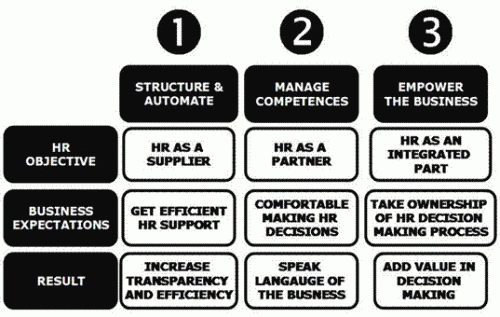In previous articles I have made my point on why HR is not an agent of change and the miserable state HR is in nowadays. In this article I want to focus on what HR should be doing in order to get out of this isolation and into the value chain (*). More precisely, there are 3 steps to take for HR in order to become a business partner.
The first step consists of structuring and automating the basic HR processes. This requires documenting the procedures, drawing the HR processes and streamlining them, and most of all: holding HR people accountable for them. As such, the first milestone to achieve is to become a reliable supplier to the business.
The second step consists of managing the competences. This implies diving into the business and spending at least 30% of your time out of the office and into the business. Competence, performance, career and succession are empty words if there are no activities in a value chain to put them against. Putting the right person on the right place requires some knowledge of that person’s role in the value chain of the organization.
The third step for HR is empowering the business by outsourcing the core part of their activities … to the business. Whereas step 1 may include the outsourcing of administrative tasks to a shared service center, this step will require a handover of activities to the business. That way, HR processes get managed where they live and exist: on the shop floor among the people.

As the diagram above indicates the business expectations change as HR follows this step-by-step approach. These business expectations indicate the value HR should be creating for each step on the way. From this diagram it is clear that one should not try to empower the business in HR decision making from the very first step. Instead you should get the basics right first and get to know the business in the second place before you even know which decisions you can outsource to the business.
In the beginning of this three step process most of the attention will be spent ‘below the bottom line’: automating the basic and repetitive stuff. However, as you move along, automation and outsourcing of the basic personnel administration will free up time.
It is my contention that HR should be spending every minute of extra time as a result of automation in going (physically) to the business; even if that means joining their sales force on the road or getting their hands dirty on the shop floor. The point is that during step 2, HR will be building solutions (systems, procedures, structures, trainings, etc.) that are tailored to the business and then aligning them with the firm backbone that was established in step 1.
Finally, the third step is to shift a part of the HR responsibilities to the business. This only works with a firm backbone of basic HR processes (step 1) and HR solutions that are tailored to the business (step 2). This is where business people really start to use the HR tools at their hand in order to drive business decisions. In other words, at this point HR has shifted from a cost center to a value driver for the business.
It is a myth that HR needs a seat at the executive table in order to practice strategic HRM. Strategic HRM is a matter of reclaiming your place in the value chain in three steps: get the basics right, get into the business and shift the ownership to the business. As controversial as it may seem, giving away parts of the personnel administration to outsourcing entities and giving away parts of the HR decision making to the business makes HR more powerful as a business partner.
_________________
(*) The value chain was first described by Michael Porter in his 1985 book, Competitive Advantage. The value chain categorizes the generic value-adding activities of an organization. The "primary activities" include: inbound logistics, operations, outbound logistics, marketing and sales, and services. The "support activities" include: administrative infrastructure management, human resource management, information technology, and procurement. The value chain is a powerful analysis tool for strategic planning. Its ultimate goal is to maximize value creation while minimizing costs.


Pingback: Luc’s Thoughts on Organizational Change » Blog Archive » More Evidence on the HR-Gap()